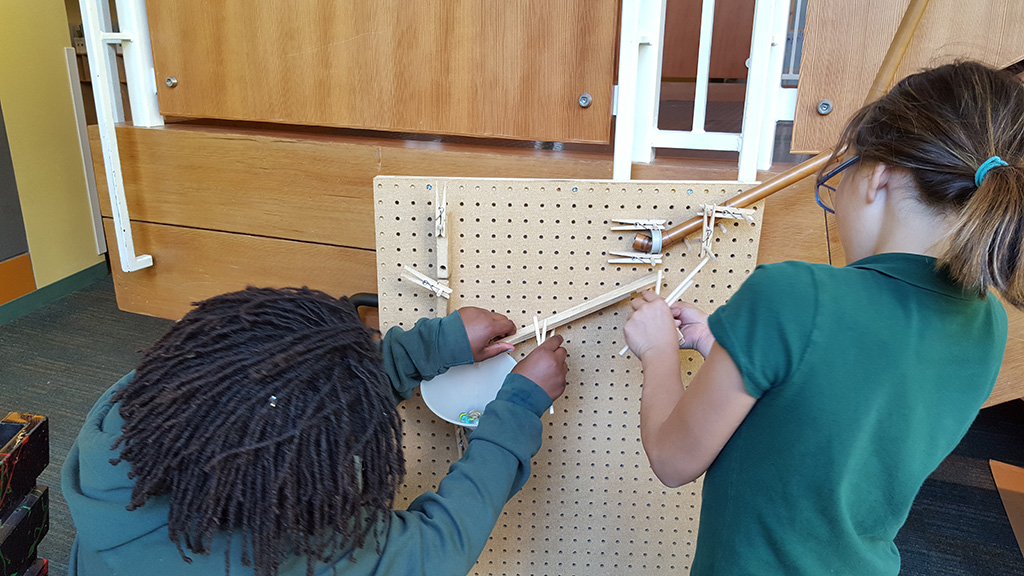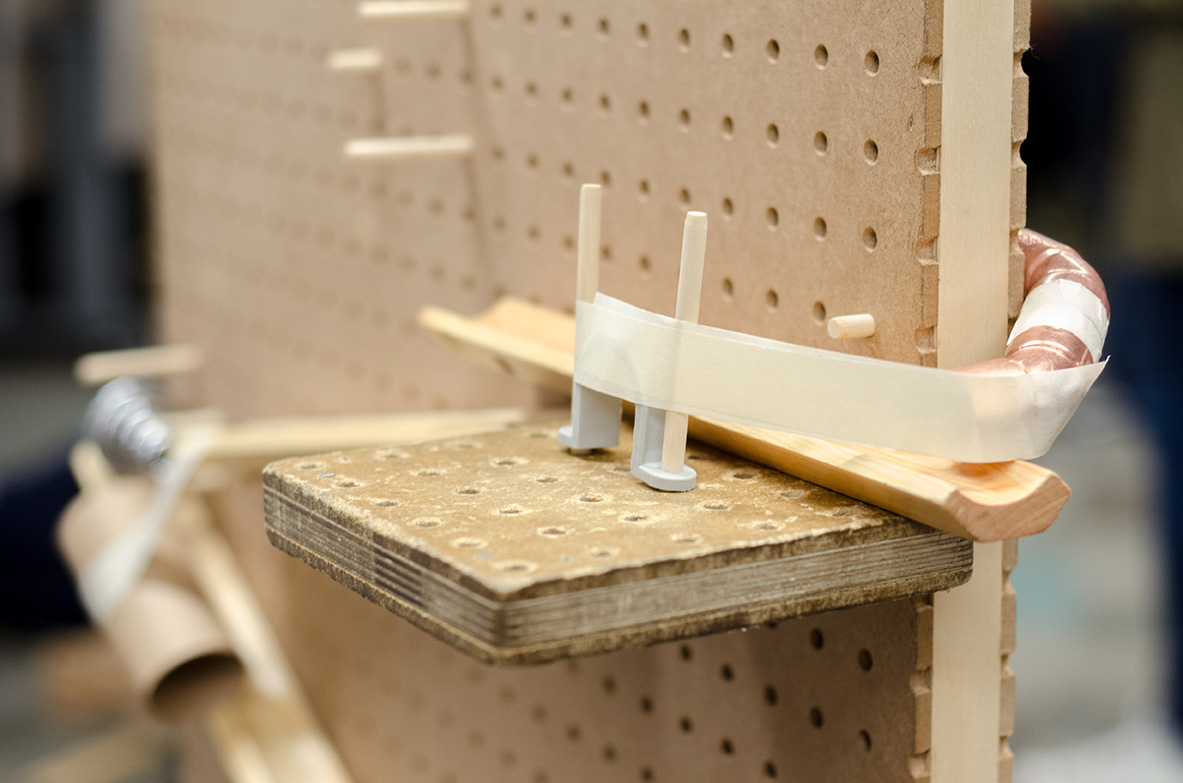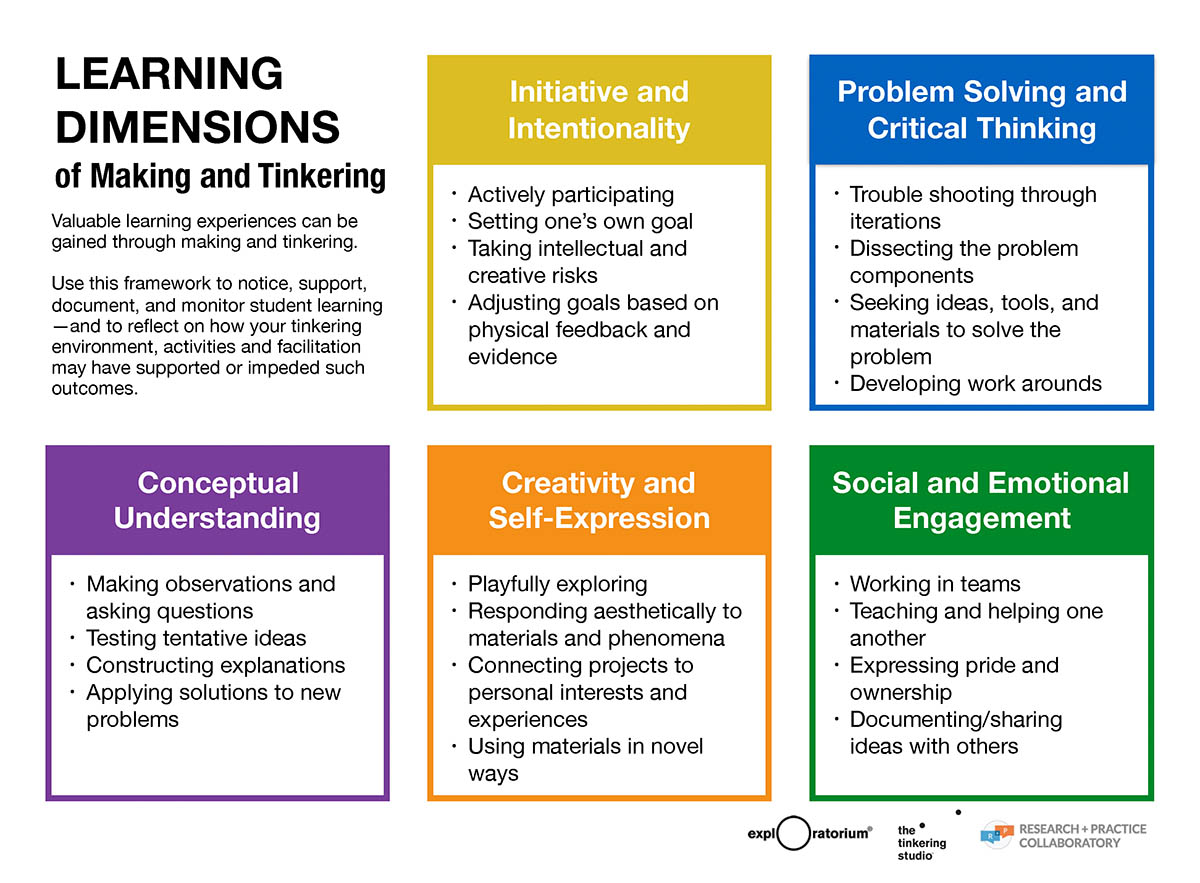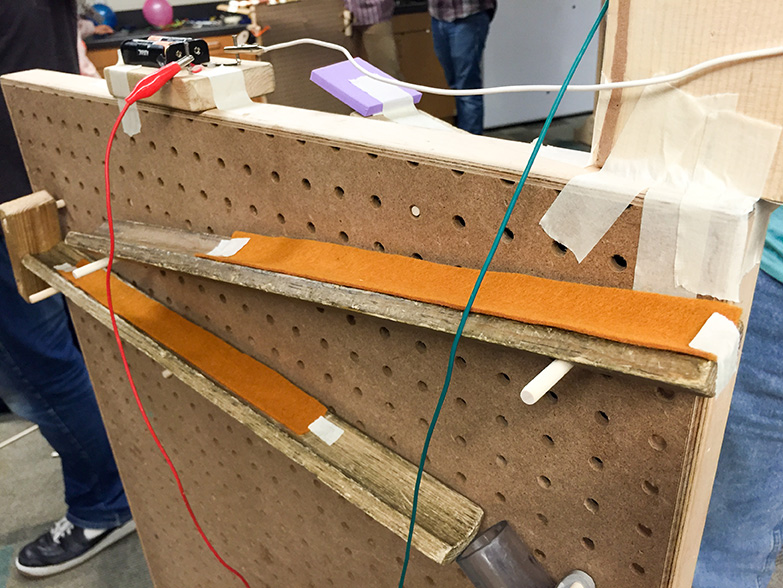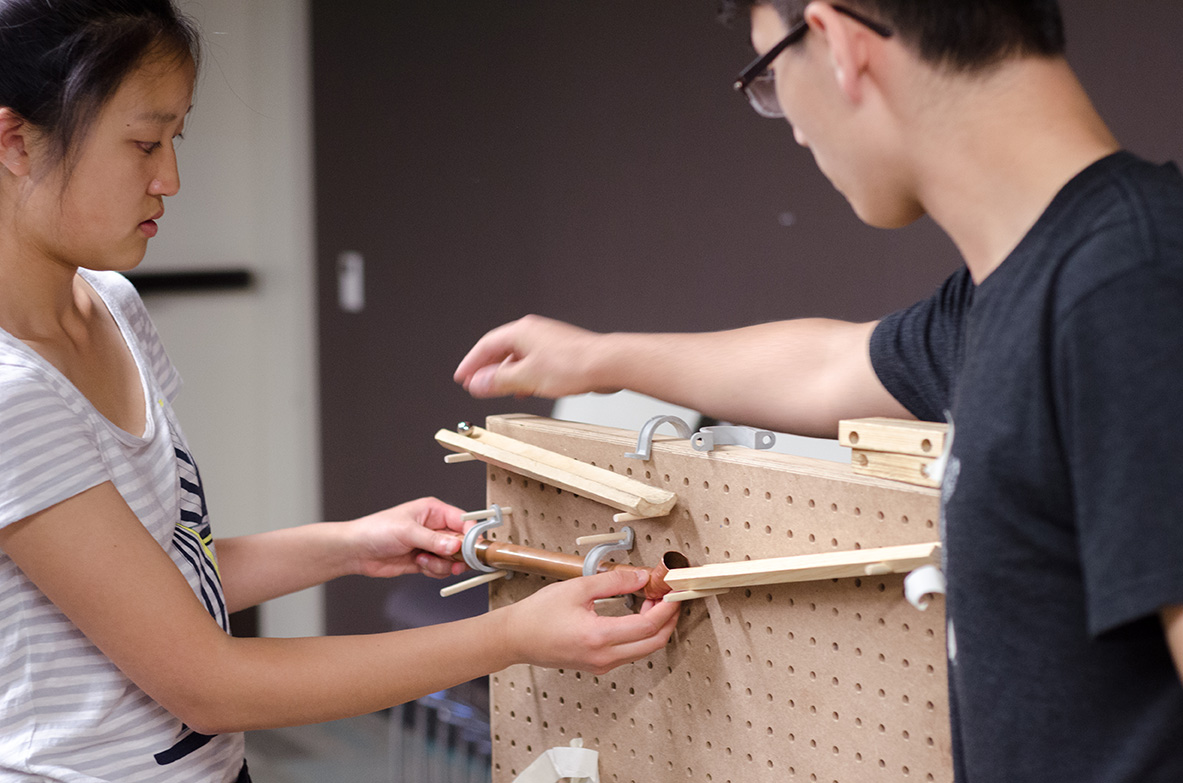Research to Practice, Practice to Research
Making Deeper Learners
A Tinkering Learning Dimensions Framework
Connected Science Learning July-September 2018 (Volume 1, Issue 7)
By Bronwyn Bevan, Jean J. Ryoo, Aaron Vanderwerff, Mike Petrich, and Karen Wilkinson
Educators from the Exploratorium Tinkering Studio and the Lighthouse Community Public Schools explored how out-of-school Making and Tinkering programs could support learning that flowed into the school day.
After he was impressed by seeing his friend Katrina using a soldering iron in the after-school tinkering program, sixth-grader Stephan decided to sign up for the program the next semester. [All names of students and educators are pseudonyms, created to protect their identities and privacy.] His first project was Marble Machines, for which he was given a four-foot-high pegboard, a bucket of marbles, and a range of building materials. The goal was to build a pathway that would get a marble to move slowly down the board.
Unlike other students, Stephan decided to wrap his ramp around both sides of the pegboard, increasing the distance (and thus the time it took) for the marble to descend along the machine. Over the course of 90 minutes, he encountered a host of challenges. First, he realized the marbles moved too quickly when the slope of his wooden ramp was too steep. He adjusted the ramp angles, determining the most gradual slope possible. Then he tested different materials (such as felt and foam) for lining the ramps to slow the marble further. He struggled for some time to connect the ramps on the front and the back of the board. Finally, he figured out how to use the flexibility of a Slinky to create a wrap-around. However, the Slinky drooped a little and the marble tended to get stuck in it. Stephan propped it up using extra pegs, repeatedly testing his solution and adding pegs where needed. As he neared completion of the project, he placed metal bowls at the bottom of the board to catch the marbles and made a new discovery: The marbles created a delightful pinging noise when they landed in the bowls. Excited, Stephan went back to the top of his machine and began adding different metal objects along the path, allowing the marble to make a slow and whimsical musical journey down the board.
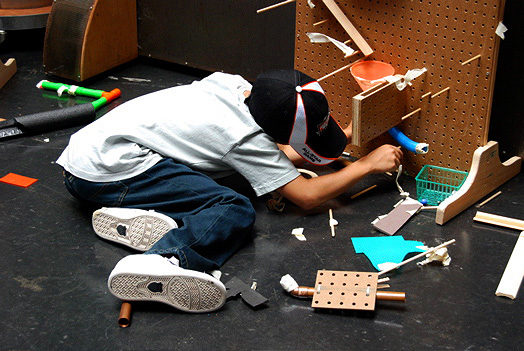
Background
It’s not hard to see that when kids are engaged in making and tinkering activities, they are enthusiastic, focused, and sometimes extraordinarily inventive. In STEM-rich making and tinkering, we see youth actively grappling with the phenomena, concepts, and tools of science, technology, engineering, and mathematics (STEM) to design, build, and test their constructions. This kind of active and self-directed learning is a powerful model for what we want to see young people doing in school; it represents what some people call “deeper learning,” in which ideas and concepts are learned in meaningful and applied contexts, and learning becomes more resilient and transferable (NRC 2012).
But time is the big commodity in school. How does time spent on making and tinkering activities connect with and advance learning goals that schools and teachers have for students across the curriculum? What kinds of dispositions and capacities do students develop that can be applied in new contexts and even other content areas? If making and tinkering represent a form of “deeper learning,” do making and tinkering also help young people become “deeper learners,” and what does this mean in the classroom?
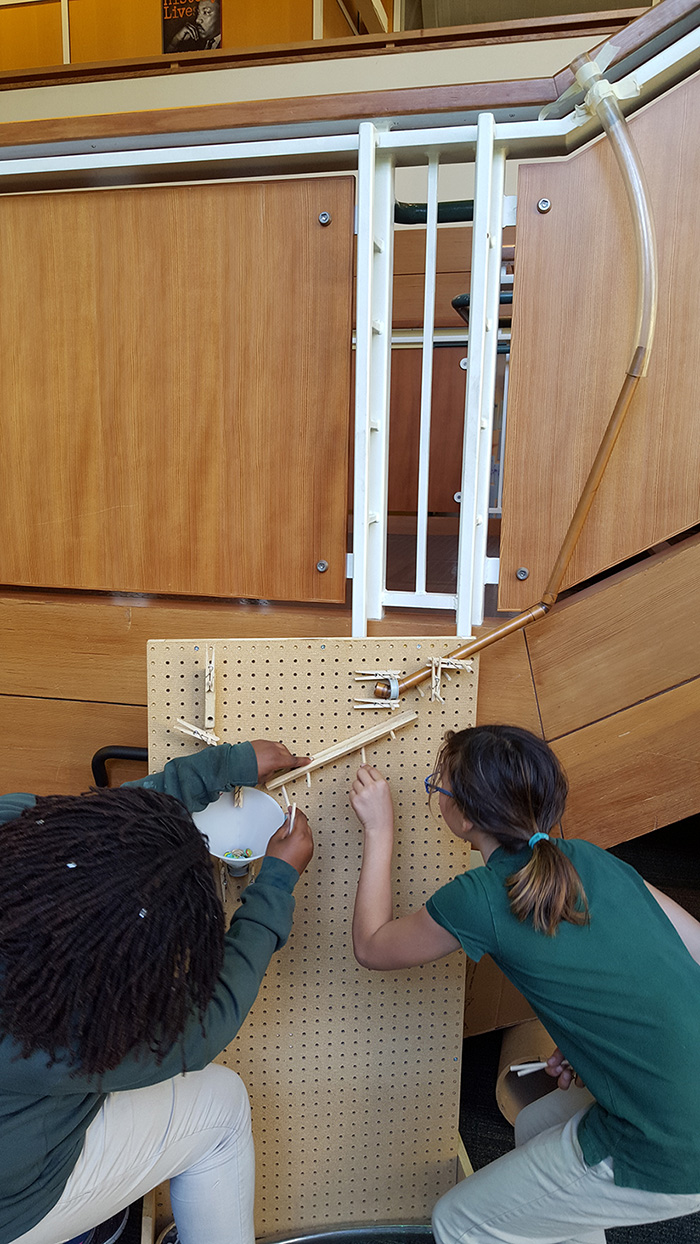 In 2015 educators from the Exploratorium Tinkering Studio and the Lighthouse Community Public Schools in Oakland decided to collaboratively explore how out-of-school making and tinkering programs could support learning that flowed into and was valued during the school day. We were interested in documenting students’ development of the conceptual, dispositional, and social-emotional learning that classroom teachers felt made students stronger. Our plan was to use what we learned to create a “Learning Dimensions Framework” that highlighted what this valued learning looked like in making and tinkering, so that other educators could design and facilitate their programs to achieve similar outcomes.
In 2015 educators from the Exploratorium Tinkering Studio and the Lighthouse Community Public Schools in Oakland decided to collaboratively explore how out-of-school making and tinkering programs could support learning that flowed into and was valued during the school day. We were interested in documenting students’ development of the conceptual, dispositional, and social-emotional learning that classroom teachers felt made students stronger. Our plan was to use what we learned to create a “Learning Dimensions Framework” that highlighted what this valued learning looked like in making and tinkering, so that other educators could design and facilitate their programs to achieve similar outcomes.
A research–practice partnership
To pursue these goals, we formed a research–practice partnership (RPP). In RPPs, educators and researchers are equally involved in identifying the research question, making meaning of the data, and building capacity to use the results of the study to support practice (Coburn, Penuel, and Geil 2013). This type of educational research is focused on improving rather than proving—thus the deep contextual knowledge of classroom or after-school educators is critical for identifying what matters and what is actionable in the data.
Over three semesters, funded by the National Science Foundation and the Overdeck Family Foundation, our project: (1) led and documented weekly making and tinkering programs for middle school (grades 5–8) youth and (2) met, on a monthly basis, as a team of after-school educators, tinkering leaders, and learning researchers to review data, reflect on practice, and distill findings and what they meant for practice. We also interviewed classroom and after-school teachers at the school.
Theory
Our study was underpinned by two related sociocultural theories of learning: cultural-historical and critical pedagogy (Freire 1970; Stetsenko 2017; Vygotsky 1962). This meant that we paid attention to how young people were supported, by each other and by adults in the room, to draw on their own experiences, ideas, and cultural resources to participate in and contribute to the Maker community and its activities. In the process, we noted how students exercised and developed their agency—their ability to take action and to own their own learning—including their ability to learn from, as well as teach, one another.
Our project differentiated between tinkering and making. Both involve the construction of an object. In making that construction might involve following step-by-step instructions or it might be open-ended. For example, when we make a chocolate soufflé, we might first follow a recipe, but when we have more experience, we might tinker with the recipe or even improvise from scratch. In some cases this tinkering might produce a perfect soufflé. In others, perhaps the first time we try, we might end up with something resembling chocolate pudding… which could be delicious over ice cream! Both approaches are “making,” but tinkering sits at the more creative and improvisational end of the continuum, where things could “fail” in unexpected and sometimes wonderful ways (Bevan 2017). With no blueprint or recipe, tinkering activities demand creative problem solving. Materials, phenomena, and models inspire ideas. Facilitators, fellow tinkerers, and a larger culture of tinkering, support learners to realize their ideas (Resnick and Rosenbaum 2012).
A theoretical premise of this project was that students would develop a sense of agency as they grappled with and mastered STEM concepts, tools, and phenomena in order to realize their ideas.
Tinkering and making do not replicate formal engineering practices, but they reflect the everyday ways in which individuals—including engineers and scientists—design, build, and refine solutions for particular and immediate questions. As in formalized engineering practices, tinkerers work through challenges in their designs, test their designs, and frequently redesign based on test results. As with some formal engineering projects, optimizing performance in tinkering sometimes has to be balanced with realizing one’s creative or aesthetic goals. Along the way, tinkerers develop deeper understanding of and affinity for the nature of the materials they are working with, and how phenomena (such as the relationship of slope to velocity, or of scale and stability) operate. This knowledge can lay the groundwork for the development of increasingly sophisticated engineering practices (Bevan et al. 2015). Perhaps even more importantly, tinkerers can be inspired to pursue further opportunities to engage in design and engineering, whether in everyday, classroom, or professional settings.
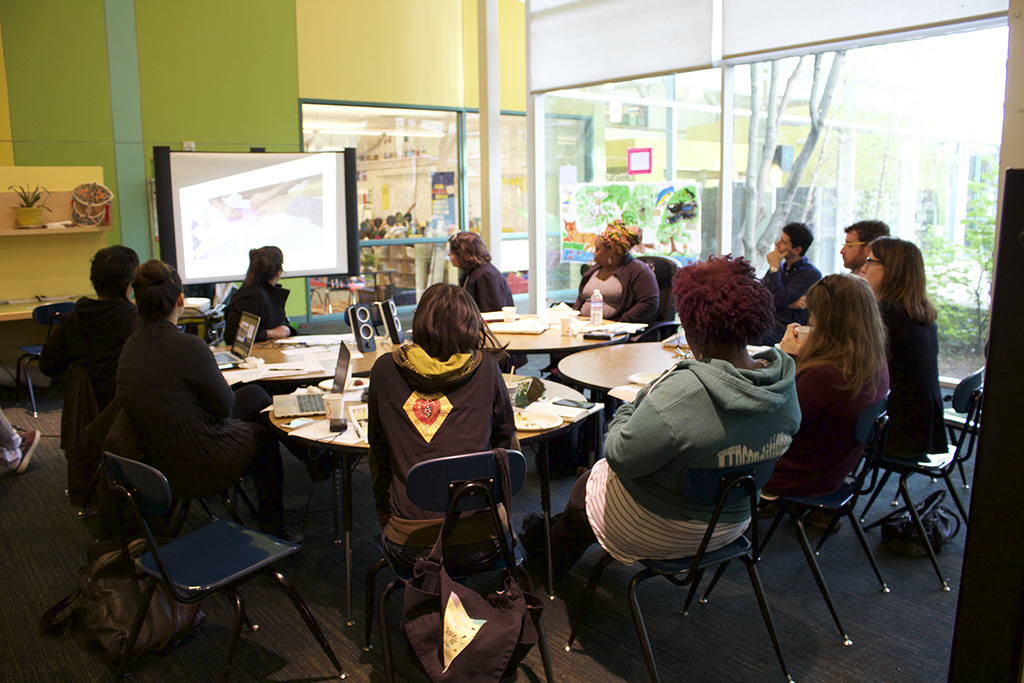
Data collection
Educators from our RPP co-designed three sequential, semester-long tinkering units: Circuits & Electricity, Motion & Mechanisms, and Light & Shadow. Each tinkering unit consisted of six to eight activities. Each semester, the after-school program met for two hours each week for 10 weeks.
Using participant observation methods, researchers documented the after-school program through observation field notes, videos, photos, audio recordings, student surveys, student journal entries, and interviews with students and adults. Students were administered items taken from two validated instruments on creativity and problem solving. These asked Likert scale questions asking students to rate themselves on items such as, “Friends ask me to help them think of ideas or solutions.” Interviews addressed a range of questions, including asking both students and teachers to describe examples of if and where ideas or skills developed in the after-school tinkering program were used in the school day.
Each month, following a model developed at Lighthouse for classroom teachers, we held (and documented) a 90-minute “inquiry group” meeting involving five after-school educators and one administrative leader from Lighthouse and three museum educators and three researchers from the Exploratorium to:
- Review research data documenting students’ after-school learning trajectories.
- Reflect on the relationship between after-school educators’ learning goals, program design strategies, and the evidence of student learning outcomes that researchers were collecting.
The work of the partnership was oriented toward enriching after-school educators’ daily teaching and learning, and identifying the key student learning benefits that we were documenting together. We focused on these goals through iterative group analyses of that program documentation. Over time, we surfaced, clustered, and refined the descriptors of what participants saw and valued. To inform our own future program design and research, including our national professional development workshops, and the broader research and policy discussions about the student benefits of making and tinkering when they are incorporated into the school agenda, we distilled the project findings into a Learning Dimensions of Making and Tinkering Framework (see Figure 1).
As noted above, our theories of learning had us attend to the ways in which STEM was taken up as a tool to help students successfully participate in and contribute to activities valued by the learning community (the after-school program itself). In this process, we noted the ways in which the activities created contexts for students to deepen their thinking and understanding and exercise their agency (their self-expression, self-direction, and sense of belonging). We were less concerned with whether a student got something to work well or quickly, and more concerned with whether and how a student became invested in his or her own idea.
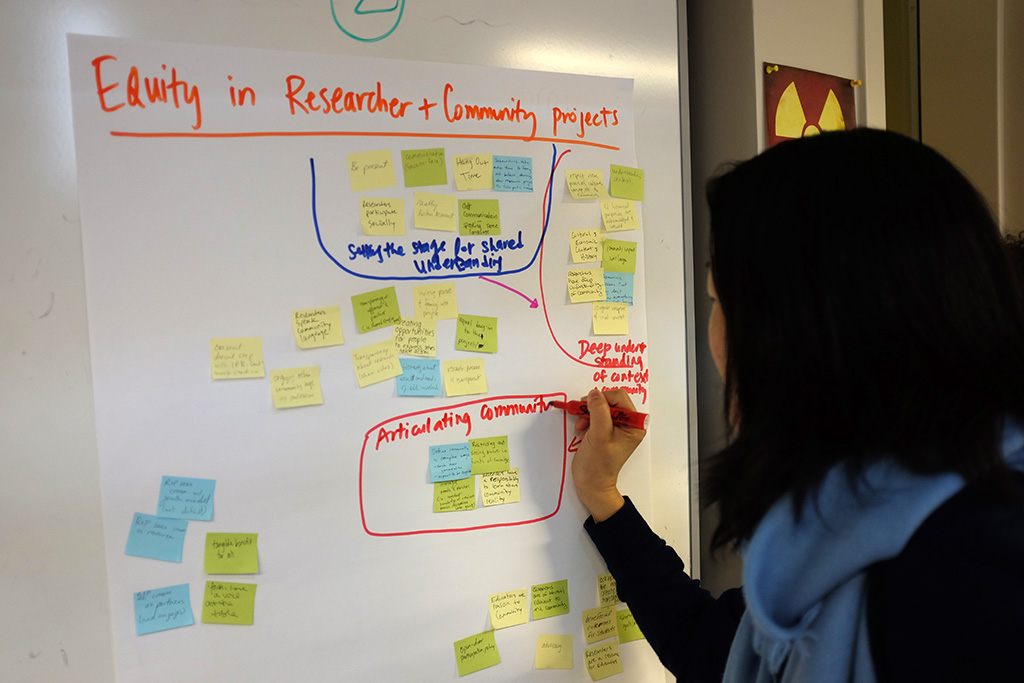
With these commitments as a starting point, the RPP team began to make lists of the valued learning activities and outcomes we could see students engaging in when we reviewed field notes or watched videos together. After-school educators shared examples from their own program activities, and we began to see recurring patterns of the kinds of actions and outcomes that educators were striving for and valued. Discussing and exploring these student activities led to new insights. For example, persistence—driven by a student’s commitment to his or her own idea—was a learning disposition that we all saw and valued. But one after-school educator, in describing her students’ struggles with a project, noted that it was equally important for students to recognize when it was “time to walk away,” exercising both judgment and agency to recognize that an idea was unworkable or the pay-off not worth it. This was an important idea to bring to the making literature (i.e., students learning enough about how something is working to recognize when it cannot be made to work with the given materials or timeframe) and is especially relevant to the literature on tinkering, because by its nature tinkering demands persistent iterations. It is therefore important to recognize that persistence is not always the wisest choice. It also added nuance to the larger literature on “grit”: Under conditions where there is clearly a right answer and the activity is designed so that it is always achievable, it may make sense to desire all students to get to that end point. But in more open-ended situations, exercising judgment about when to stop, switch gears, or rethink a goal may be equally as important.
Over the three semesters of collaborative reflection on our data, we began to home in on five main dimensions of learning, shown in Figure 1, that we saw and valued in after-school time and during the school day. (These dimensions build on prior work developed in a museum setting, where Tinkering experiences are transient (Bevan et al. 2015), and some dimensions of learning may not be recognizable, simply because the learner is not known and follow-up with classroom teachers is not feasible.) In developing the particular clusters and indicators shown in Figure 1, we debated issues such as whether persistence is an indicator of initiative and intentionality (e.g., learners persisted because they set their own goal) or social and emotional engagement (e.g., learners persisted because they were committed to being a productive program member). We agreed that persistence probably reflects both—or that you rarely have one without the other—but, for the sake of clarity and simplicity, we decided to limit the dimension of social and emotional engagement to issues related to belonging, and the dimension of initiative and intentionality to issues related to developing and pursuing a purpose.
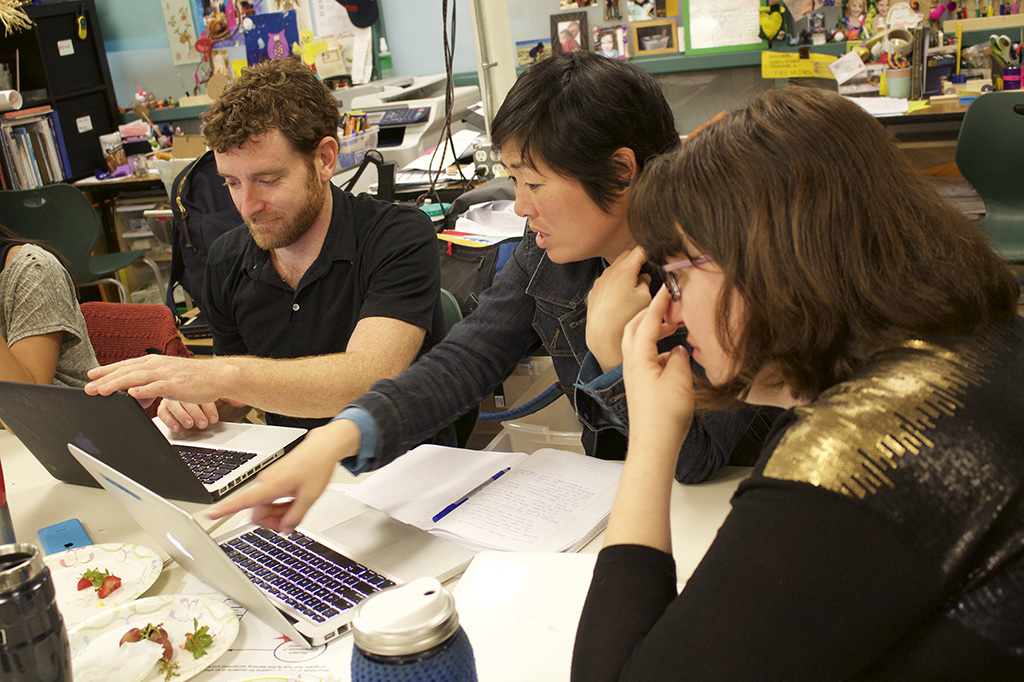
Learning Dimensions of Making and Tinkering Framework constructs
There are a few important caveats to keep in mind about the Learning Dimensions of Making and Tinkering Framework. First, as the vignette included at the beginning of this article illustrates, the dimensions do not develop chronologically, linearly, or hierarchically. Frequently, multiple dimensions are intertwined, which is what makes tinkering such rich learning experiences. For example, as one develops an idea, one becomes socioemotionally invested in it and will persist in problem-solving to realize one’s goal. At the same time, in the course of troubleshooting, ideas can shift, understanding can deepen, and a sense of ownership and pride can increase. Second, many of the learning dimensions only became evident over time through observations of students as they make and tinker, excerpts from student science journals, and interviews with students and/or their teachers. Third, and foundational to this work, is our finding that the dimensions do not “just happen” without careful attention paid to the nature of the activities, environment, and pedagogy.
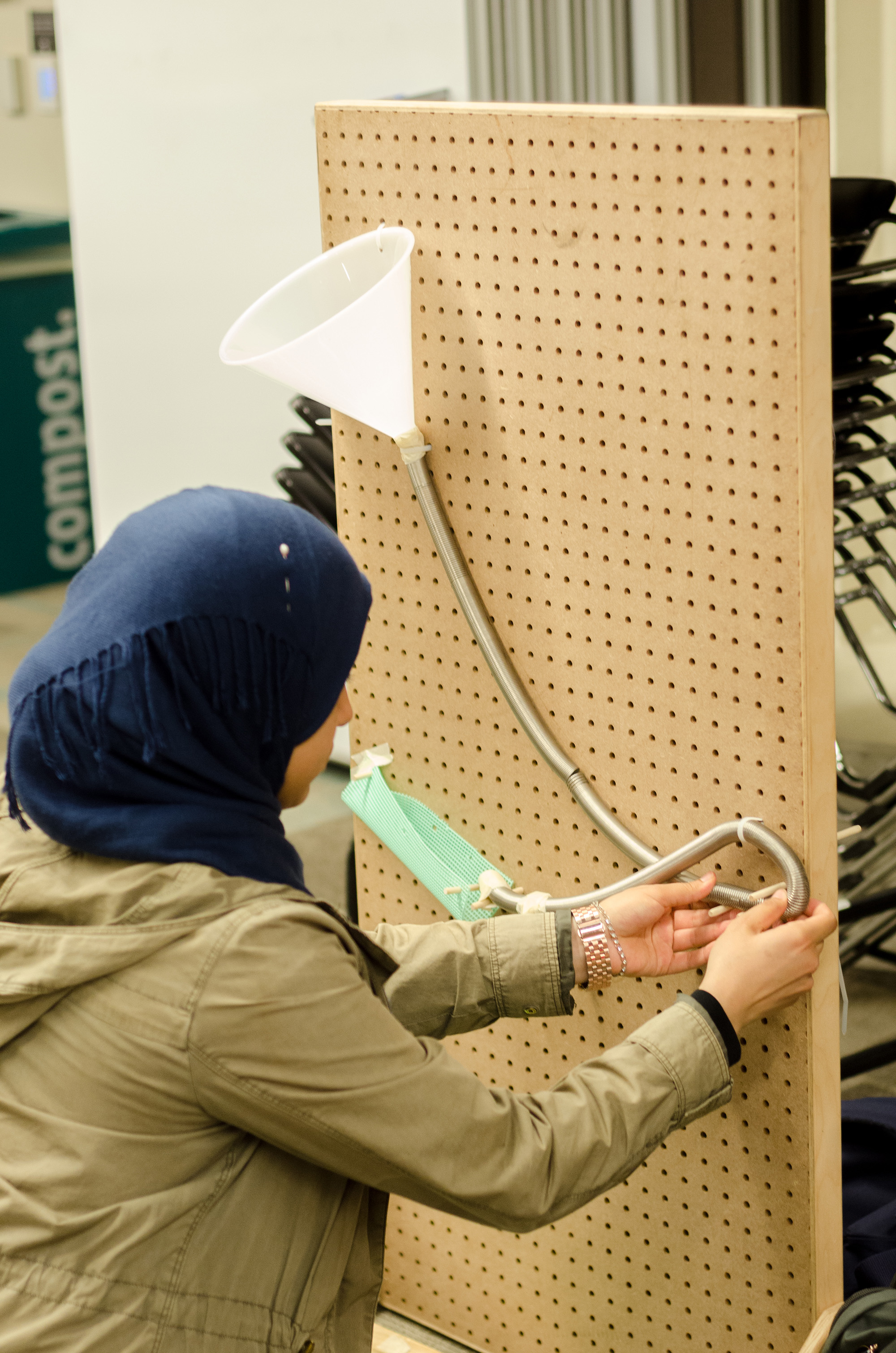 Ultimately, the purpose of the Framework is to guide the design and facilitation of making and tinkering activities and environments that can produce these learning outcomes. For example, educators can ask themselves, “Is this activity designed in ways that allow for ‘ongoing complexification’ to allow for a variety of student ideas and intentions? Or is there really only one direction or end point possible?” The Framework can also be used as a reflective tool to formatively assess student learning. For example, educators can ask themselves, “Is there evidence that students are ‘refining and focusing their inquiries over time’?” Such evidence would indicate that students have a deepening conceptual grasp of the activity’s key variables and the behaviors of the relevant phenomena.
Ultimately, the purpose of the Framework is to guide the design and facilitation of making and tinkering activities and environments that can produce these learning outcomes. For example, educators can ask themselves, “Is this activity designed in ways that allow for ‘ongoing complexification’ to allow for a variety of student ideas and intentions? Or is there really only one direction or end point possible?” The Framework can also be used as a reflective tool to formatively assess student learning. For example, educators can ask themselves, “Is there evidence that students are ‘refining and focusing their inquiries over time’?” Such evidence would indicate that students have a deepening conceptual grasp of the activity’s key variables and the behaviors of the relevant phenomena.
In the next section, we provide brief summaries of each of the dimensions and what it looks like when they come to life.
Dimension 1: Initiative and intentionality
This dimension refers to the ways in which tinkerers develop and pursue their ideas, and how those intentions lead them to deepen their commitment to the process of tinkering and the community of tinkerers and ultimately their understanding. Stephan, in the vignette at the beginning of this article, began his Marble Machines project with an idea and intention to make the track wrap around his pegboard. This commitment to an idea was a risk—nobody else was doing it, and he had no model to imitate. It unleashed a range of opportunities and constraints: It created the need to devise and troubleshoot pieces that could curve and connect two sides of the board. He tried using flat wooden ramps at various angles, as well as shaping sheets of foam paper into tunnels that could wrap around the board. Eventually, he found that the Slinky served as the best material for wrapping the marble’s pathway around the board, but then had to figure out what Slinky slope would best facilitate slower, rather than faster, marble rolling. He also had to grapple with the “valleys” created by the slumping Slinky. This is an example of how tinkering creates personally meaningful contexts for students to persist in their engagement with STEM phenomena and materials, propelled by their own ideas.
Classroom educators we interviewed repeatedly saw this learning dimension come to life in their classrooms. One classroom science educator described students’ commitment to their ideas in a classroom activity involving building models of sharks they were studying:
Their [shark] models were unbelievable. … Suyen was looking at a model but trying, retrying, balling up the clay again, redoing the fin. … And then the painting, getting the right color paint, do the counter shading, ‘So how am I going to represent the gills?’ So anyhow, her shark is amazing, her seven-gill shark. It blew me away. And I couldn’t help but make the connection that Katrina and Suyen are both in this after-school program class where they’re learning [that] failure leads to success and trying something. I can’t help but think the reason their models were so amazing is because they were willing to take risks and then try it again. … The fact that [Suyen] didn’t give up and she kept persisting is very different [from] what I know about her from the past, having taught her last year. When things would get hard, she’d give up. So I’m wondering how that’s having an effect on her persistence.
Our project identified a number of indicators for the ways in which makers and tinkerers demonstrate initiative and intentionality:
- Actively participating
- Setting one’s own goal
- Taking intellectual and creative risks
- Adjusting goals, based on physical feedback and evidence
Dimension 2: Problem solving and critical thinking
This dimension refers to the processes in which students encounter, analyze, and troubleshoot problems in their constructions. Indeed, tinkering is defined in the research literature—and distinguished from more recipe-like making activities—as “playful and improvisational problem-solving” (Resnick and Rosenbaum 2012). Through problem solving, students’ efforts become more focused and intentional, and less (but not completely less!) a matter of trial-and-error. This involves dissecting and exploring the different components of the problem. For example, when building his initial marble run, Stephan noticed that the surface of the wooden ramps were slick, causing the marbles to roll faster than desired. After testing different slopes, Stephan decided to explore how fabrics laid along the wooden ramps might increase friction and further slow the marble’s course. He first tried foam paper, but when this had little effect, he searched for more textured materials, eventually choosing felt.
The value of making and tinkering as a context for problem solving was recognized by a middle school librarian who worked with youth from different schools—some that have making and tinkering programs, and some that do not:
I can see the kids who are coming up from [Local] Elementary, which has a very rich making culture, are much more, not only skilled, but they’re also much more willing to problem solve. And they’re ready to go.
Classroom teachers also noted that the ability to be a creative problem solver and critical thinker are characteristics and skills highly desired in noneducational contexts. Another middle school science teacher noted:
They’re building skills that will help them academically in the future. And they’ll just be successful in any school context. But actually, I guess even more importantly, those skills are important because they’re important in life … specifically the [problem solving] aspect of, ‘If I’m stuck, I try another way.’ I feel like some of my students have built that [quality], and some have totally not, and I just think with the more complex problems that are given in the Common Core context, that’s really important. And that’s more relevant to life, because the problems you solve in life are never going to be as cut and dry as the problems you usually see [in] math word problems.
Indicators that students are engaged in developing their problem-solving skills while making and tinkering include:
- Troubleshooting through iterations
- Dissecting the problem components
- Seeking ideas, tools and materials to solve the problem
- Developing work-arounds
Dimension 3: Conceptual understanding
This dimension refers to the process of developing familiarity with and understanding of the STEM concepts and phenomena learners are working with in their constructions. Tinkerers develop conceptual understanding by working with phenomena, concepts, and tools to achieve their ideas and goals. Although this understanding may or may not be fully articulated, it can serve as a resource (i.e., a prior experience, an interest, a level of confidence) for further development through pointed instruction. Through iterative design and redesign, youth can refine and make visible how they understand phenomena, such as the relationships between symmetry and balance or slope and velocity.
For example, Stephan faced a number of initial constraints in getting the marble to move slowly down the length of a five-foot high pegboard. His aesthetic choices created further complexities and constraints—forcing choices of particular materials that brought new challenges with them. His work involved repeated testing and modifications to his design, with the overall goal of creating a marble run that also produced music. Tinkering creates contexts where youth grapple with constraints, test, and retest, because they are committed to realizing their idea. As one middle school science teacher noted, it provides powerful contexts for students to deepen their understanding, because understanding helps them achieve goals that matter to them:
Writing is hard for them. A lot of them are English learners. But after we did the making projects, I feel like their focus paragraphs, where they had to write about it, [were] a lot clearer than other times they’ve written about something we just read about or talked about or watched a video about. … They were able to explain it more eloquently. That was really interesting. And I think it comes with understanding it better, and having to use that language. Because as you’re making, you’re constantly asking them to use the vocab and use the language and explain to their partners why they want to add this attachment, or take off this part.
We have documented a number of indicators for the ways makers and tinkerers demonstrate their development of conceptual understanding, including:
- Making observations and asking questions
- Testing tentative ideas
- Constructing explanations
- Applying solutions to new problems
Dimension 4: Creativity and self-expression
Creativity sits at the heart of making and tinkering, encompassing the aesthetic, personal, and playful ways in which learners respond to materials and projects. Developing one’s own idea, and creatively working with materials and phenomena to realize it, makes the experience deeply satisfying and personal for students. This is evident not only in Stephan’s creative use of a Slinky, but also in how his wrap-around marble run became a musical inquiry as he responded to the sounds he found the marble could make and sought to more fully realize his creative vision. Unlike more recipe-like making activities, tinkering activities that don’t come with blueprints tend to encourage and amplify students’ creative ambitions. This, in turn, creates unintended constraints that can complicate and drive ongoing complexification and care in students’ work, requiring careful measurements, balancing, positioning, or finishing touches, and leading to richer engagements that can deepen understanding over time. As one middle school math and science teacher described it:
I think the individual nature of [students] having their own vision for their project creates a certain amount of investment that pushes them to keep going, even when they’re stuck. Versus if they’re stuck on a math worksheet, they’re just automatically not as invested as [they would be in] a project that they’re really trying to execute in a specific way to achieve their own specific vision. I think that creative aspect supports persistence in kind of a unique way. Whereas persistence in a traditional classroom—I feel like is harder to build in kids.
Tinkering also frequently involves “audiences” for the work—fellow makers and tinkerers, the broader school community, or parents or friends for whom the objects are presented as gifts. As another middle school math and science teacher notes, this dimension of activity leads to great focus on craftsmanship, which entails mastery of materials, tools, and phenomena.
[In our book-making project,] we talked about how to make your illustrations more accurate. For example, one girl had her sharks walking. And so they were walking on their fins. And so during the feedback session, we talked about how, well, sharks really don’t walk on their fins, but how [she could] revise this to [make it] more scientifically accurate. That they’re swimming to school; they’re not walking to school.
Indicators we have found that tinkerers are exercising and developing their creativity include:
- Playfully exploring
- Responding aesthetically to materials and phenomena
- Connecting projects to personal interests and experiences
- Using materials in novel ways
Dimension 5: Social and emotional engagement
This dimension refers to the ways that makers and tinkerers build confidence in their work, collaborate with others, and gain a sense of ownership and pride in their projects. Through their active participation in and leadership within a making or tinkering community, students develop a sense of belonging and build their identities as creative thinkers. A key dimension of learning in making and tinkering involves recognizing, and being recognized for, one’s accomplishments and contributions (e.g., ideas, skills, collaboration) to the community. Stephan came to the tinkering program through his friendship with another student, Katrina. Katrina asked Stephan if he wanted to learn to solder, and when he agreed, she used the same teaching methods she experienced in the program to help him solder LEDs onto her own project.
Reflecting on how Katrina, despite an initial fear of soldering, came to master soldering and later became the go-to expert for soldering in the after-school tinkering program, a math teacher noted:
There are so many chances for kids to become experts in something [through making and tinkering]. And then somebody else needs to do it. So there’s a super authentic: ‘Hey, I can teach you this.’ That’s really built confidence. And I know Katrina a little bit. And she can be pretty quiet in class. So it’s cool to see her step out of her shell [and teach her peers to solder] … I’ve seen that progression in a lot of students through making.
We have documented a number of indicators for the ways makers and tinkerers demonstrate their social and emotional engagement within making and tinkering communities, including:
- Working in teams
- Teaching and helping one another
- Expressing pride and ownership
- Documenting/sharing ideas with others
Conclusion
The Learning Framework we developed has been used in face-to-face and online professional development programs offered by the Exploratorium Tinkering Studio. It provides language that helps educators articulate the kinds of learning outcomes that they want to see and do through making and tinkering. It also can be used to more critically examine whether and how their making and tinkering activities, facilitation strategies, and the social and material environment they have created are impeding or supporting these outcomes. For example, if moving from trial and error to more focused investigations is a hallmark of students developing their critical-thinking and problem-solving skills, educators can ask whether activities have been designed to demand such work. Are educators providing the time, materials, and choices that can support students as they problem-solve? Are educators serving as thinking partners to help students articulate and reflect on why their constructions are working or not, to help students engage critically?
For the Exploratorium Tinkering Studio, articulating such outcomes and dimensions is part of an ongoing engagement with the potential power of making and tinkering for student learning, and how it can be enriched with reflection and care. For Lighthouse, one of the key outcomes of the RPP project has been to elevate the voices of after-school educators, who are often at the margins of the education system, due to historical inequities including lower wages, unstable hours, and lack of certification.
In many schools, including Lighthouse, there are status issues between in-school and out-of-school educators. The collaboration served to give the school’s after-school educators a space to reflect on their experiences and understandings around student- and maker-centered learning that were then shared with administrators and daytime staff. This flipped the normal flow of information and expertise from after-school to classroom. As they developed, the Learning Dimensions served as a way to focus the RPP team’s time together, providing common things to look for and a way to build shared understandings together. Each time an educator shared a story of practice, the team would work to tie it back to the dimensions of learning and how they supported student agency.
There were also challenges. Early on, when the after-school educators were not yet familiar with the project, it took some time for them to internalize the concepts and dimensions of learning to the point where they could use them to reflect. It also took a few cycles of bringing stories of practice to the group before everyone else could bring their own and discuss them together.
Through both the achievements and challenges of our RPP efforts, we were driven by a commitment to tinkering as a context for students to develop, apply, and make visible their thinking and understanding. We all recognized that when tinkering projects are designed to support students’ pursuit of their own ideas, students become more committed to persisting to understand and realize their ideas. When activities are designed with multiple entry points and pathways, and room for complexification, students are more likely to develop an idea that they care about. When STEM phenomena and concepts are embedded in the tools and materials that students work with to realize their ideas, students take up STEM with purpose and commitment. This leads to deeper learning and deeper understanding.
The interplay between creative vision and STEM understanding is what, in part, has driven the enterprise of science and engineering as human, cultural practices. Making and tinkering can bring joy to the process of learning science, as students develop understanding, dispositions, and social skills that can support and deepen their sense of belonging and their capacities as learners.
Bronwyn Bevan (bronwynb@uw.edu) is senior research scientist at the University of Washington’s Institute for Science + Math Education in Seattle, Washington. Jean J. Ryoo (jeanryoo@ucla.edu) is the director of research of the Exploring Computer Science project at the University of California, Los Angeles, Graduate School of Education and Information Studies. Formerly, she was director of the Institute for Research and Learning at the Exploratorium in San Francisco, California. Aaron Vanderwerff (aaron@makered.org) is the Director of Learning at the Maker Education Initiative in Oakland, California. Formerly, he was the Creativity Lab Director at Lighthouse Community Public Schools in Oakland, California. Mike Petrich (2us@exploratorium.edu) coleads the Tinkering Studio at the Exploratorium in San Francisco, California. Karen Wilkinson (tinkering@exploratorium.edu) coleads the Tinkering Studio at the Exploratorium in San Francisco, California.



